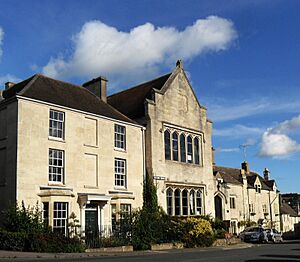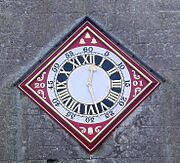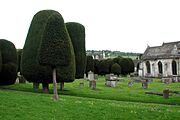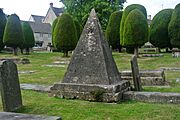Painswick facts for kids
Quick facts for kids Painswick |
|
|---|---|
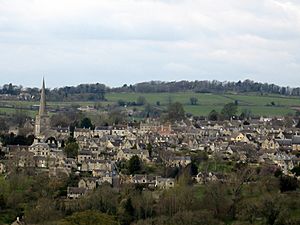 Painswick from Longridge |
|
| Population | 3,026 |
| OS grid reference | SO866098 |
| Civil parish |
|
| District |
|
| Shire county | |
| Region | |
| Country | England |
| Sovereign state | United Kingdom |
| Post town | Stroud |
| Postcode district | GL6 |
| Dialling code | 01452 |
| Police | Gloucestershire |
| Fire | Gloucestershire |
| Ambulance | Great Western |
| EU Parliament | South West England |
| UK Parliament |
|
Painswick is a small town and civil parish in Gloucestershire, England. It's located in the Stroud District. The town first grew because of the wool trade. Today, it's famous for the many yew trees around its church and for its special Rococo Garden.
Most buildings in Painswick are made from local Cotswold stone. Many old houses have attic rooms that face south. These rooms were once used by weavers as workshops.
Painswick sits on a hill. From here, you can see one of the beautiful Five Valleys. The town has narrow streets and old, traditional buildings. It also has sports teams for cricket and rugby. There's a golf course just outside the town. You can find Painswick Beacon in the nearby hills.
Contents
History of Painswick
People have lived in the Painswick area for a very long time. We know this from the Iron Age (around 800 BC to 100 AD). You can see an old defensive earthwork called Kimsbury hill fort on Painswick Beacon. From there, you get wide views over the Severn Vale.
A Roman villa was built north of the village. Experts believe it was built in the late 2nd century. A local monastery called Prinknash Abbey was started in the 11th century.
Painswick is first mentioned in the Domesday Book of 1086. It was called Wiche, which means 'dairy-farm'. The name Painswik first appeared in 1237. It comes from an earlier lord of the manor, Pain Fitzjohn, who died in 1137. 'Pain' was a common name back then.
Painswick During the English Civil War
During the first English Civil War (1642–1645), the city of Gloucester was important for the Parliamentarian side. It was surrounded by King Charles I's army. After the siege of Gloucester ended on September 5, 1643, the Royalist army stayed overnight in Painswick. King Charles I himself stayed at Court House.
The soldiers caused some damage. You can still see marks from two small cannonballs on the tower of St. Mary's parish church.
Painswick House and Rococo Garden
Painswick House was built in the 1730s. It is the home of Baron Dickinson. Its famous Rococo Garden was designed in the 1740s by Benjamin Hyett II.
St. Mary's Parish Church
-
The Church of England parish church of Saint Mary is a very old and important building.
The Church of England parish church of Saint Mary is a very old building. It is listed as a Grade I building, meaning it's historically important. The churchyard is famous for its many ancient yew trees.
Local Traditions and Folklore
Every year, on the first Sunday after September 19, Painswick celebrates "Feast Sunday." In the past, people would feast, drink, and have fun. Two customs have been brought back and are still done today: "clipping the church" and eating "dog pie."
Clipping the Church
"Clipping the church" involves mostly children, but also adults. They join hands, dance around, and "embrace" St. Mary's parish church. It's a way of showing love for the church.
The "Dog Pie" Custom
The "dog pie" is not made of dog meat! It's a plum pie baked with a small porcelain china dog inside. This custom started between 1870 and 1880.
The Yew Tree Legend
There's a local legend about the churchyard's yew trees. People say there will never be more than 99 yew trees. If a 100th tree tries to grow, the Devil will pull it out! However, a count of the trees has shown there are actually more than 100.
Paradise Valley
During the Civil War, when King Charles I's soldiers were in Painswick, a story says the King went up to Painswick Beacon. Looking at the beautiful valley to the east, he supposedly said, "This must be Paradise." Since then, that valley and a small village on its western side have been called Paradise.
The Pan Procession
In the 18th century, a group of important people, led by Benjamin Hyett II, held a yearly parade for Pan. Pan is a god from Greek mythology. During the parade, a statue of Pan was carried, and people shouted "Highgates! Highgates!" This tradition stopped in the 1830s. It was brought back in 1885 by a new vicar, but his successor ended it in 1950. Pan's statue was buried, but later dug up and placed at Painswick House.
Bow Wow Sauce
According to a book by William Black, a special sauce called Bow Wow Sauce was created in Painswick. It's a sauce meant to be served with roast meats.
Painswick Post Office
The post office in Painswick is in a very old building. It was built in 1478, making it the oldest known building in Great Britain that also has a post office inside. We don't know exactly when the post office counter opened there. In 1933, Mr. H M Strange moved the post office a short distance up the street. He was the Post Master until he retired in 1968.
Local School
Painswick has one school called Croft Primary School. It's a small school for children aged 4 to 11. It has fewer than 150 students. The school teaches both boys and girls.
Notable People from Painswick
Many interesting people have lived in or come from Painswick:
- Gerald Finzi, a composer, lived in Painswick from 1922 to 1926.
- Susan Lynch, an Irish actress, moved to Painswick in 2008 with her husband, actor Craig Parkinson.
- Charles Wilfred Orr, another composer, lived here from 1934 to 1976.
- Julian Slade, who wrote the famous 1954 musical Salad Days, grew up in Painswick. He always felt connected to the village.
- Thomas Twining, a famous tea merchant, was born in Painswick in 1675. In 1706, he opened his first tea shop in London, which became the well-known Twinings brand.
- The first Baron Dickinson lived in Painswick. His son, the second Baron, now manages the Painswick Rococo Garden.
- Robert Watkin-Mills, a singer with a deep voice (bass-baritone), was born in Painswick.
See also
 In Spanish: Painswick para niños
In Spanish: Painswick para niños



